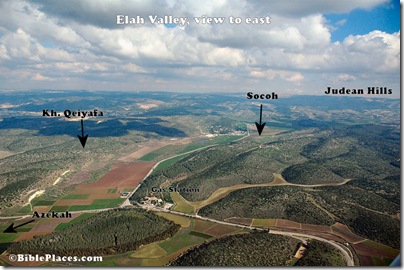The Jan/Feb 2009 issue of Biblical Archaeology Review has a summary of the Kh. Qeiyafa excavations. Most of the information has already been reviewed at this blog and others, but the article is nicely presented with beautiful photographs (online teaser here). The article concludes with editor Hershel Shanks pressing excavator Yosef Garfinkel to release photographs of the ostracon.
So what does the inscription say? The decipherment has been assigned to Haggai Misgav, a Hebrew University epigrapher. “So can we see a high-resolution image of the inscription?” I asked Garfinkel. “Maybe our readers would have some helpful suggestions for Misgav,” I urged. All to no effect. Yossi stuck to the time-honored tradition that a readable picture of the inscription remain a secret until the scientific report is published in a scientific journal by the scholar assigned to publish it: Remember the Dead Sea Scrolls.
“Be a hero! Break the mold,” I urged Yossi. No way, he responded. He did tell us that the first line contains the Hebrew words “don’t do,” and that “king,” “judge” and “slave” also seem to be legible, but “it is still premature to talk about the content,” he maintains.
So when will we see a picture of the inscription with all of its indistinct letters? If the past is any guide, it will be a year or more. Is this any way to run a railroad?
Haggai Misgav has a reputation for being a very competent epigrapher. But he can only be helped, not hurt, by what other scholars (and even amateurs) have to say prior to his official publication. You can be sure, he will show the ostracon and high-resolution pictures (and infrared images as well) to friends and colleagues. He will take some of their suggestions and thank them in his publication of the ostracon. So why not enlarge the circle? It cannot hurt, and it may help. In any event, an early look at the inscription will not detract from his fame as the publisher of the famous ostracon from Qeiyafa.
As an aside, if you have this issue of BAR, or online access by personal or institutional subscription, take a look at the third article in the “Strata” column, “Gold-Plated Building Stone Found Near Temple Mount.” Very interesting.
(HT: Joe Lauer)
The discussion about the site identification of Qeiyafa is continued by Nadav Na’aman in the Journal of Hebrew Scriptures (8/24; full pdf online). He disagrees with Garfinkel’s identification of the site as Shaaraim, in his article entitled “Shaaraim – The Gateway to the Kingdom of Judah.” The abstract reads:
The article discusses the location of the city of Shaaraim mentioned in Josh 15:36 and 1 Sam 17:52. It first argues that its proposed identification with Khirbet Qeiyafa, north of the Elah Valley is mistaken. Then it argues that Shaaraim is located on the main road that led from the Valley of Elah to the city of Gath. This article proposes that the place-name Shaaraim means “gate” and that the city was named so because it was located on the western border of Judah with Philistia, a place that was seen as the gateway to the kingdom of Judah.
Na’aman makes some points that I have made previously, and that I think are obvious and difficult to circumvent. I am working on an article on the subject and thus will restrain myself from further analysis at this time.
